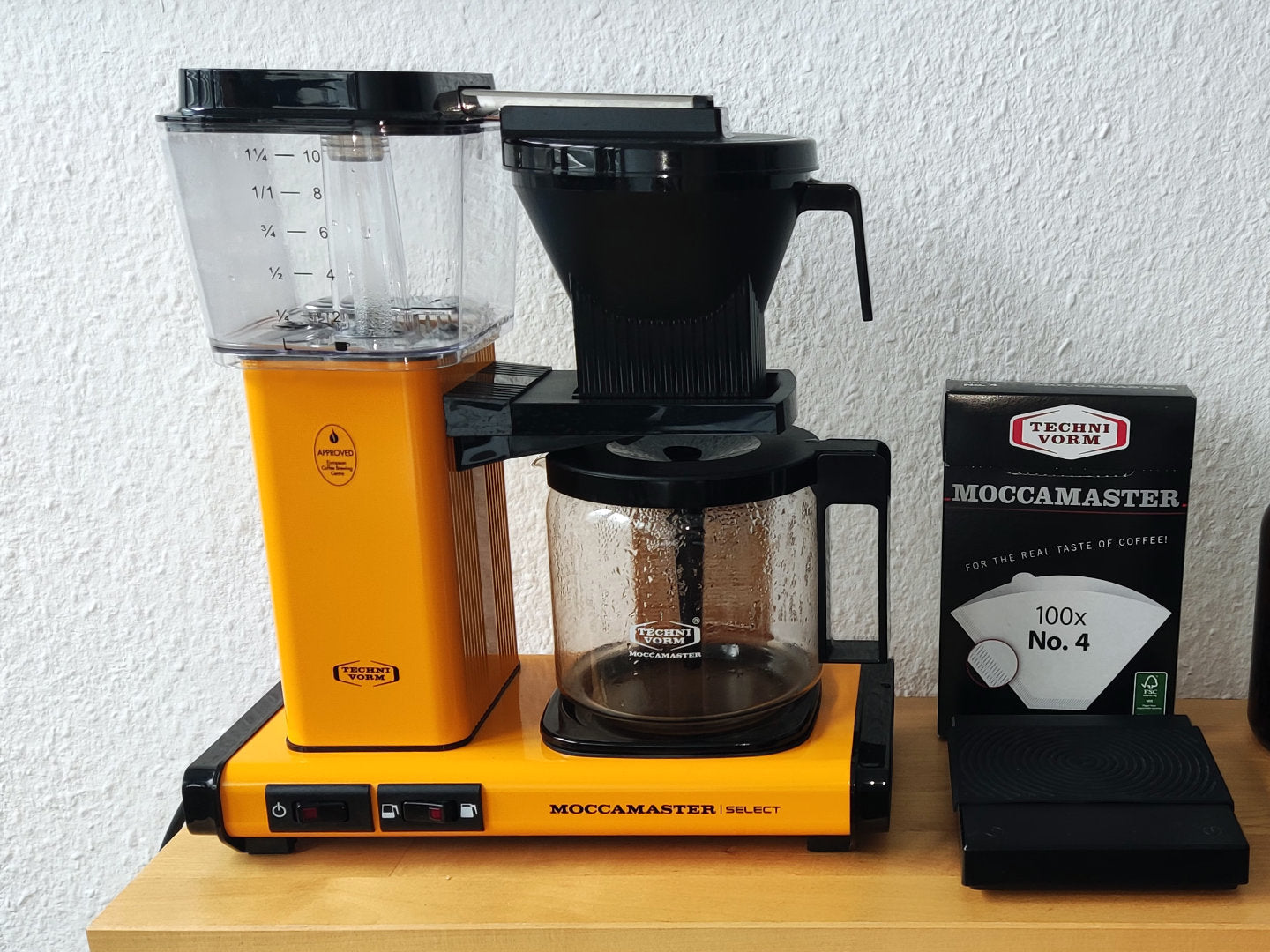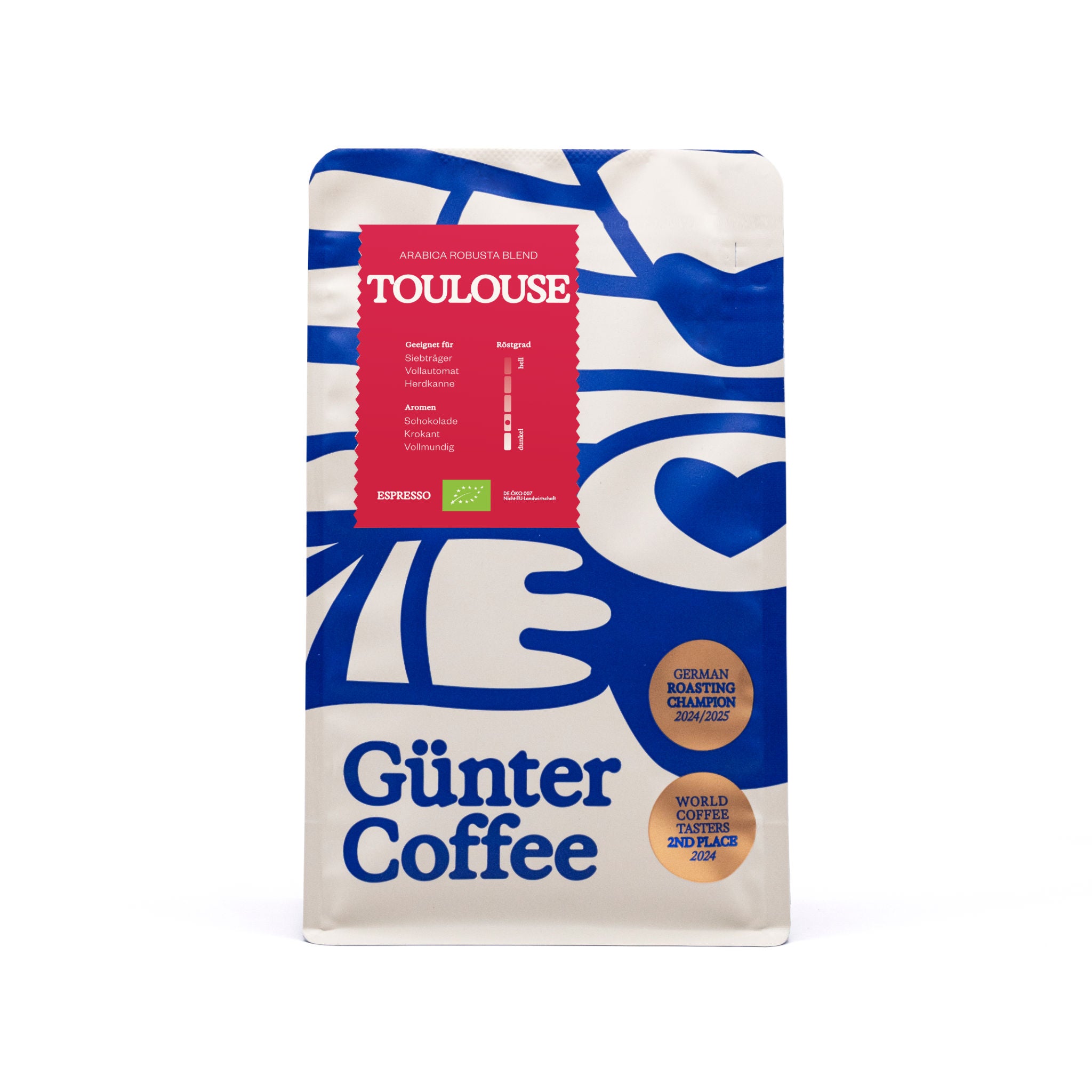We developed the example recipe for our Omniroasts and filter coffees, which are labeled accordingly in the shop. Since we roast most of our espressos comparatively light, some of them are also suitable for filter processing.
To properly prepare filter coffee with the Moccamaster (KBG Select, KBGT), you need the following equipment.
Equipment for preparation with the Moccamaster
- Moccamaster coffee machine
- Moccamaster filter paper No. 4
- coffee grinder
- Fine scale
- coffee beans
Everything there? Then let's get started! If you need anything else, you can find everything in our online shop.
1. Set the recipe
The basis for every coffee recipe is the coffee-to-water ratio (brew ratio). We use this to determine the strength and taste of the filter coffee. For the Moccamaster we recommend a ratio of 1:16, i.e. 64 g of coffee per liter of water. With the Moccamaster you can prepare a maximum of 1 ¼ liters of coffee at once. The smallest recommended amount of coffee is ~250 ml. For this we need 16 g of coffee and 250 ml of water.
2. Weigh the amount of coffee exactly
We place a vessel, for example our hand grinder, on a fine scale, tare it to 0 and fill in the coffee beans until the scale shows the desired amount. Here we work with 0.1 gram accuracy.
3. Coffee grinding level
We choose the grinding level to be slightly finer than coarse sea salt.
The following applies: the finer the grind, the longer it takes for the water to work its way through the ground coffee. The longer the contact time between water and ground coffee, the stronger the extraction. It's worth experimenting a bit here.
It is important that we have a coffee grinder that produces a homogeneous grinding result. This means: The ground bean particles should all be approximately the same size.
4. Off to the Moccamaster
Now we fill the water into the Moccamaster container. Thanks to the printed filling levels, it is not necessary to weigh or measure it beforehand.
We insert the filter, rinse it with warm water (optional) and then add the precisely weighed ground coffee. Now we press the left toggle switch to start the machine.
The right toggle switch is initially in the left position. This allows you to change the flow time of the water on the Moccamaster KBG Select model (slower on the left, faster on the right).
5. Enjoy filter coffee
The 250 ml of water made its way through the coffee. Now we swirl our pot a little so that the coffee cools down briefly. Filter coffee develops better when it is not completely hot and also tastes very good cold. The prerequisite for this is that we use high-quality coffee beans.
Is your coffee bitter, sour, watery? Adjust recipe!
For a good, balanced filter coffee, we solve around 20% of the coffee particles from the ground coffee. If the coffee tastes too bitter or even astringent, we have removed too many particles. However, if it is too acidic and watery, we have dissolved too few particles.
If the coffee tastes bitter, we want to remove less from the coffee grounds. To do this, we grind more coarsely in order to shorten the contact time between water and coffee. Conversely, if the coffee is too acidic or watery, we have to remove more particles from the coffee. Analogous to over-extraction, we choose a finer grind for under-extraction.
We recommend changing only one parameter at a time to have full control and get closer to the perfect filter coffee.
Since coffee consists largely of water, its properties (water hardness and composition) play a major role in the taste. You can find out more about this in our guide to coffee water.
Another tip: For darker roasted coffee beans, it is often worth reducing the extraction a little. You can achieve this by grinding coarserly or by letting the water flow through faster (point the KBG Select toggle switch to the right).
Regular cleaning of the Moccamaster is crucial
To ensure that your coffee from the Moccamaster always tastes the way it should, you can't avoid cleaning the machine regularly. The manufacturer Technivorm recommends cleaning after 100 cycles, i.e. after a pack of Moccamaster filter paper has been used up.
We use the cleaning agent Clean Drip for our Moccamaster. You can find the instructions for cleaning in the product description.























4 comments
Nico | Günter Coffee Roasters
Hi @Phil, thanks for your comment. I use my Moccamaster daily for 250 to 500 ml of coffee at a time. I find it produces good coffee with both amounts of water. When brewing amounts ≤ 500 ml, be sure to use to rocker switch on your Moccamaster KBG on the left setting (half-full server icon).
However, if you’re regularly making only 250 ml coffee, Moccamaster also makes smaller machines specifically for that. They’re called Moccamaster Cup-One but the color selection is limited to only two, unfortunately.
If you’re not happy with your 250 ml coffee that your Moccamaster produces, try to follow our tips for adjusting the recipe in the second to last paragraph of the article.
Hi @Phil, thanks for your comment. I use my Moccamaster daily for 250 to 500 ml of coffee at a time. I find it produces good coffee with both amounts of water. When brewing amounts ≤ 500 ml, be sure to use to rocker switch on your Moccamaster KBG on the left setting (half-full server icon).
However, if you’re regularly making only 250 ml coffee, Moccamaster also makes smaller machines specifically for that. They’re called Moccamaster Cup-One but the color selection is limited to only two, unfortunately.
If you’re not happy with your 250 ml coffee that your Moccamaster produces, try to follow our tips for adjusting the recipe in the second to last paragraph of the article.
Phil
Hey! Do you find that the coffee tastes worse when using only 250ml compared to 500/750ml? Also is the water hot enough during the short 250ml process? Or would you recommend the Moccamaster even at small batch sizes?
Hey! Do you find that the coffee tastes worse when using only 250ml compared to 500/750ml? Also is the water hot enough during the short 250ml process? Or would you recommend the Moccamaster even at small batch sizes?
Nico | Günter Coffee Roasters
@Joyce: Thanks for your comment. As spoons and cups are not generally standardized around the world, we strongly recommend to work with a scale. Even one that’s not super precise would be better than not using one at all.
Assuming you’re from the US, where one cup is defined as 240 milliliters, and a table spoon is defined as 14.8 ml, you would need about 120 grams of coffee, which makes around 7 to 8 tablespoons of ground coffee.
@Joyce: Thanks for your comment. As spoons and cups are not generally standardized around the world, we strongly recommend to work with a scale. Even one that’s not super precise would be better than not using one at all.
Assuming you’re from the US, where one cup is defined as 240 milliliters, and a table spoon is defined as 14.8 ml, you would need about 120 grams of coffee, which makes around 7 to 8 tablespoons of ground coffee.
Joyce
How many spoons of ground coffee should I use for 8 cups of water
How many spoons of ground coffee should I use for 8 cups of water